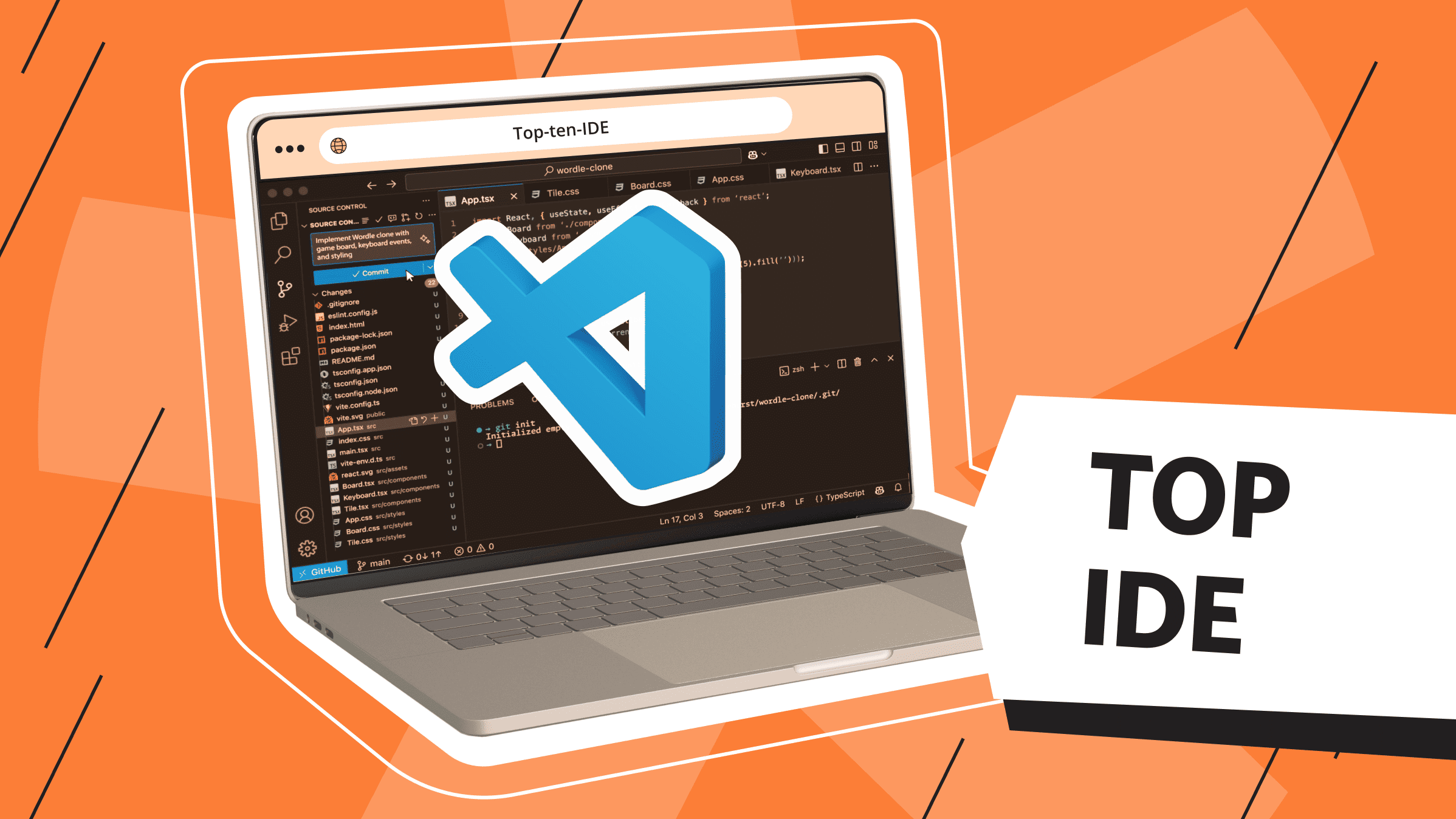
As development teams seek better ways to streamline their work, many are turning to AI IDE tools within the growing field of intelligent coding environments. But with so many options available, choosing the right tool can be challenging. In this guide, we’ll explore how these AI coding tools can improve workflows, reduce time spent on repetitive tasks, and help bring new ideas to life, no matter the size of your project.
What is an AI IDE?
To begin this odyssey, let’s clarify the basics. What does IDE stand for?
IDE stands for Integrated Development Environment—a software suite that combines code editing, debugging, and build tools under one roof. A standard IDE helps you write and manage code, but an AI IDE lifts that concept into the next league. Instead of simply providing color-coded syntax or basic autocomplete, an AI IDE uses deep learning models within your coding environment. It scans your code base and uses advanced logic to offer real-time suggestions, flag potential bugs, and recommend best practices based on your context.
These enhancements transform a dull text editor into a coding AI IDE—a space where you can refine logic, generate entire code snippets, manage testing, and ensure optimal code security. Some folks refer to these next-gen solutions as AI IDEs or AI AIE tools, reflecting how seamlessly they integrate into existing workflows. These platforms function as AI-powered IDEs, accelerating code development, identifying vulnerabilities, and even suggesting whole architectures.
Here's another key point: the market offers a wide range of solutions. Some platforms claim to be the best AI IDE for coding, but the real choice often comes down to how well they integrate with your tech stack and how effectively they meet your specific needs.
Ultimately, an AI coding IDE can drastically enhance your productivity—guiding your work with AI-powered code completion, vulnerability scanning, or even proposing entire code generation sequences. As we move forward, keep in mind that the “best fit” depends on your development style, team demands, and long-term project vision.
Top 10 Artificial Intelligent Coding Tools

If you want to boost developer productivity and enhance code comprehension, these 10 AI-driven solutions offer a comprehensive lineup for your software development needs. From generating code and fixing errors to helping manage existing code, each AI model on this list brings something unique to the table. Whether you’re a beginner or a seasoned coder, these solutions can help streamline your coding process.
#1 Cursor

Cursor exemplifies the concept of a lightweight AI coding tool. It offers a nimble environment for quick spin-ups and everyday tasks. If you’ve ever groaned at the monotonous chore of starting a new project structure, Cursor has your back.
What Makes Cursor Stand Out?
Below is a quick overview of Cursor’s standout capabilities:
- Cursor quickly sets up new repositories or class structures, keeping your source code neatly organized.
- It understands the structure of your code and offers relevant, precise code suggestions.
- Small syntax errors and Bash commands are handled effortlessly, whether you’re working in JavaScript or Python, helping you fix issues on the fly.
- Instead of modifying entire files, it makes targeted edits exactly where needed.
Together, these features make Cursor a convenient starting point for coders who prefer minimal overhead.
What It’s Like Using Cursor
Before diving into Cursor's user experience highlights, it's worth noting that Cursor is designed to remove friction from the coding flow:
- Streamlined setup. Developers find it useful for rapidly launching frameworks or connecting to existing projects.
- Low maintenance. Cursor’s minimalist approach means fewer tangles in extensive configurations.
Users often say Cursor helps cut out busywork, allowing them to focus more on logic and creativity.
Cursor: Strengths and Weaknesses
Here’s a quick look at Cursor’s main advantages and drawbacks:
|
Pros |
Cons |
|
Simplifies project setup and scaffolding. |
Limited creative leaps in code generation. |
|
Maintains contextual awareness for relevant suggestions. |
Struggles with large-scale or deeply nested instructions. |
|
Makes minor changes without needing to redo entire files. |
Debugging integration feels too basic for complex processes. |
In conclusion, Cursor is best suited for smaller tasks and straightforward expansions rather than major codebase overhauls. Its speed and simplicity speak volumes to developers who want to get moving quickly.
Maximize your budget with our high-performance VPS solutions. Enjoy fast NVMe, global reach in over 40 locations, and other benefits.
#2 Windsurf

When the code gets complex and you need to keep multiple files consistent, Windsurf is the clear choice. This AI coding tool excels at handling diverse projects, and you can trust it to get the job done.
Core Capabilities of Windsurf
Here's an overview of Windsurf's key features, according to user feedback:
- Supercomplete. Goes beyond simple auto-completion by anticipating your overarching intent within an entire snippet.
- Inline AI. Makes changes within targeted sections while preserving stable segments of the codebase.
- Cascade. Allows you to iteratively generate or modify code blocks in a conversational style.
- Image upload. Converts uploaded visuals (such as design mockups or screenshots) into workable code.
- Web search. Fetches relevant references or documentation on the fly.
These features collectively position Windsurf as a robust tool for multi-faceted coding tasks that demand synergy across numerous files and frameworks.
Windsurf in Action
Windsurf centers on advanced tasks, not just routine auto-fill. Here are some additional user insights that highlight its capabilities:
- Reliability at scale. Devs mention that editing multiple files or cross-referencing libraries is easier with Windsurf’s extensive context awareness.
- Scope for complexity. The tool excels at handling complex tasks like code reorganization or multi-layer refactoring.
Many users appreciate its higher-level approach. Once you’re familiar with its interface, it can handle large modifications with almost no fuss. However, its more sophisticated debugging features still need some work.
Windsurf: Benefits vs. Limitations
Here’s a breakdown of Windsurf’s main advantages and disadvantages:
|
Pros |
Cons |
|
Multi-file context awareness. |
Debugging integration lacks polish. |
|
Innovative features like Supercomplete, Cascade, and image-based code generation. |
A steeper learning curve for first-time users. |
|
Handles large-scale or cross-repository changes reliably. |
May consume significant resources. |
To sum up, Windsurf is a strong pick for tasks involving different programming languages or complicated setups. You have to climb a bit of a hill to get started, but for large teams or complex software, it's well worth it.
#3 GitHub Copilot

Many developers herald GitHub Copilot as a hallmark of AI coding tools. Born out of a collaboration between GitHub and OpenAI, it's widely recognized for its powerful code completion and broad language support. If your team relies on a storage server to host repositories, Copilot can still provide robust suggestions without forcing you into a cloud-only environment.
Copilot Feature Highlights
Let's check out Copilot's best features:
- Code completion and generation. Can generate entire blocks, from short scripts to complex sequences, thanks to a robust sense of code context.
- Adaptability. Learns your style and tailors suggestions to align with your codebase.
- Mentorship. Offers small tips that resemble micro-lessons in proper syntax or best practices.
These capabilities go beyond classic auto-fill, setting Copilot apart as an actual coding partner.
How Copilot Works for You
Here's what makes Copilot a game-changer in daily development:
- Developers create, evaluate, and refine new functionalities efficiently through rapid prototyping.
- Its broad familiarity ensures seamless integration within the GitHub ecosystem, making adoption straightforward.
Developers often mention that they feel "spoiled" by Copilot's ease of use, but AI-generated output still requires human review—especially for complex and safety-critical code segments.
Upsides and Downsides of Copilot
Here’s a quick table outlining what Copilot brings to the table and where it might stumble:
|
Pros |
Cons |
|
Increases productivity with advanced completions. |
Occasional unrelated or confusing suggestions. |
|
Works fluidly across many programming languages. |
Possible privacy or licensing concerns. |
|
Helps maintain coding style consistency throughout a project. |
Can foster overreliance if not used judiciously. |
Copilot stands out as a beloved example of an AI-powered IDE extension, yet developers must stay vigilant. The synergy is powerful—but it’s no excuse to skip best practices or manual review.
#4 Qodo

If you're looking for better tests, thorough code reviews, and advanced problem-spotting, Qodo is an AI coding tool designed for these tasks. It can scan existing structures for errors and generate solutions on the spot.
Top Functions of Qodo
Let’s take a closer look at Qodo’s core capabilities:
- Context-aware code generation. Goes beyond surface-level hints by factoring in the project’s architectural style.
- Automated testing and review. Suggests test cases, inspects logic, and spots potential pitfalls.
- Bug detection and fixing. Pinpoints trouble spots and provides recommended patches.
- Code auto-documentation. Generates docstrings or explanatory blocks to keep your code documentation well-maintained.
These features all reflect Qodo’s mission: maintaining code quality without bogging developers down in manual micromanagement.
The Qodo Experience
Before listing user reactions, it’s worth noting that Qodo has a learning curve:
- High code standards. Developers appreciate how Qodo enforces thorough testing and documentation, supporting long-term maintainability.
- Robust feedback loops. Immediate detection of logic errors and bugs reduces unexpected surprises later in the development cycle.
Teams that prioritize top-notch code stability hail Qodo’s thoroughness, though novices may find its environment slightly overwhelming at first.
Qodo: Advantages and Drawbacks
Below is a table summarizing Qodo’s strengths and potential downsides:
|
Pros |
Cons |
|
Elevates code quality through integrated testing. |
Not always beginner-friendly. |
|
Provides immediate feedback on logic flaws and coverage. |
Can slow initial development if you’re unprepared. |
|
Offers multi-language support and doc generation. |
May feel restrictive to those who prefer flexibility. |
Ultimately, Qodo’s approach suits teams that want bulletproof code. If you’re building thoroughly tested projects from the ground up, it’s a match made in AI heaven.
#5 Amazon Q Developer

Amazon Q Developer is a hybrid of code generation and cloud-based synergy, bringing an AI coding flavor that integrates with AWS solutions. If you're already using AWS, it's especially compelling.
Why Developers Choose Amazon Q Developer
Below is a highlight reel of Amazon Q Developer’s strongest attributes:
- Real-time code generation. From short snippets to entire functions, it turns minimal instructions into workable code.
- Integration with popular IDEs. Plugins for JetBrains IntelliJ IDEA, Visual Studio, and VS Code help keep your pipeline cohesive.
- Command-line interface support. Translates natural language into bash commands for a streamlined workflow.
- Security analysis and code optimization. Identifies vulnerabilities, suggests performance improvements, and helps craft unit tests.
Leveraging these features allows teams to unify coding tasks, security checks, and CLI tasks under one AI-centric solution.
Real-World Use of Amazon Q Developer
Before diving into user opinions, it’s vital to point out that Amazon Q Developer truly shines when interfacing with AWS services:
- Speeds up development. Natural language instructions convert quickly into functional code, allowing developers to skip the drudgery of boilerplate.
- Security. Integrated scanning helps keep your code secure from the start.
Users do warn that coverage might lag for less common programming languages, and potential overhead can creep in on massive projects. Even so, in an AWS-heavy shop, it remains a strong candidate.
Amazon Q Developer: Is It Right for You?
Below is a summary of the top pros and cons of using Amazon Q Developer:
|
Pros |
Cons |
|
Speeds up development and prototypes with real-time code generation. |
Incomplete support for certain languages. |
|
Bundles security scanning and performance insights into your workflow. |
Hidden costs and performance overhead may occur. |
|
Integrates neatly with AWS and leading IDEs. |
Requires a solid understanding of AWS to unlock full potential. |
For dedicated AWS users seeking an AI-powered assistance tool, Amazon Q Developer pairs robust features with the reliability of a major cloud platform.
#6 Vercel v0

Vercel v0 uses a design-centric approach, mixing visual tasks with an AI coding assistant to optimize front-end development. Even if you're running a project on a VPS, v0's design-focused workflow can simplify front-end tasks without requiring complex local setup. This tool is often recommended for developers looking to reduce uncertainty in interface design.
A Closer Look at Key v0 Features
Before exploring these capabilities, it's worth mentioning that v0 focuses exclusively on front-end development:
- UI-component creation. Build modular elements visually with no need for complex HTML/CSS coding.
- Immediate code display. Modifications show up instantly, eliminating traditional refresh cycles.
- AI-driven design guidance. Offers color palette and structural recommendations for refined interfaces.
- Cross-platform compatibility. Produces code that works across web and mobile environments.
- GitHub connectivity. Built-in version control streamlines team collaboration.
These features make the transition from design to implementation a lot easier.
Working with v0
Before we jump into user impressions, keep in mind that v0 is not designed to handle complex back-end logic:
- Non-designers can easily create polished UIs thanks to its straightforward interface.
- You don’t need to refresh the browser––changes appear instantly.
Design teams appreciate how v0's AI hints and visual creativity work hand in hand, but large-scale backend tasks might need a separate environment.
v0’s Pros and Cons
Here’s a quick reference table summarizing v0’s main strengths and weaknesses:
|
Pros |
Cons |
|
Simplifies UI/UX with AI-driven design suggestions. |
Limited functionality for non-visual (backend) development. |
|
Real-time preview streamlines iteration. |
Professional plans may be costly for small teams. |
|
Integrates with GitHub for seamless version control. |
Doesn’t address deeper performance or architectural issues. |
If you're often stressed about front-end design, v0 is a breath of fresh air. It combines the visual and functional elements of front-end design while speeding up the feedback cycle.
#7 Tabnine

Tabnine has made a name for itself in the segment of AI coding tools. It focuses on advanced auto-completion and a chat interface for real-time Q&A. It's also known for its wide range of language support.
What You Can Do with Tabnine
Before jumping into bullet points, remember that Tabnine started as a pioneer in code completion:
- AI-autocomplete. Predictions for popular languages (e.g., JavaScript, Python) are often spot-on and efficient.
- AI-chat. Allows developerss to pose direct queries, from broad code questions to specialized snippet generation.
Developer Impressions of Tabnine
Before exploring user feedback, here’s what you should know about Tabnine’s universal integration:
- It works seamlessly with different famous IDEs, from JetBrains to VS Code.
- It doesn't interfere much with your interface. Tabnine usually runs in the background, stepping in only when necessary.
Tabnine's suggestions can be spot on, but they might not always be 100% accurate. It's important to be mindful of context alignment.
Is Tabnine Worth It? A Quick Breakdown
Below is a simplified table revealing Tabnine’s advantages and pitfalls:
|
Pros |
Cons |
|
Exceptional auto-completion capabilities across multiple languages. |
Occasional context mismatches or irrelevant hints. |
|
Smooth integration with popular IDEs. |
Some advanced settings require learning. |
|
AI-chat for clarifications and snippet discussions. |
May provide overly generic solutions. |
Tabnine offers a user-friendly solution for coders who want more in-depth completions and basic Q&A. Just remember to always double-check the suggestions, especially for complex or specialized projects.
#8 Bolt.new

Another star in the AI coding tools pantheon, Bolt.new targets full-stack developers looking for an all-in-one environment accessible directly from the browser. It seamlessly integrates front-end, back-end, and database tasks .
Bolt.new’s Smartest Features
Below is a concise overview of Bolt.new’s main offerings:
- JavaScript, TypeScript, Node.js, and other technologies work seamlessly in a single environment.
- Real-time feedback allows for quick debugging and issue resolution.
- You can also create, manage, and integrate cloud databases directly within the interface.
All these features are designed to make your life easier, and provide you with a stable environment without requiring local installations.
User Experience
Before getting into user reactions, remember that Bolt.new's goal is to make development easier:
- Developers can code from any device with a stable internet connection, eliminating the need for environment setup.
- Quick updates streamline debugging, reducing guesswork and speeding up iterations.
Most developers value not having to deal with all the nightmares of local configuration, though reliance on constant internet connectivity can be a drawback in some circumstances.
Bolt.new: Reasons to Use—and Cautions to Note
The following table breaks down the pros and cons of Bolt.new:
|
Pros |
Cons |
|
Eliminates local setup complexity. |
Requires a strong internet connection. |
|
Integrates front-end, back-end, and databases into one environment. |
May not support niche or exotic frameworks fully. |
|
Accelerates debugging with real-time previews. |
Cloud performance can vary, impacting load times. |
Bolt.new is a solid choice for developers who want a simple, centralized approach to app development. Just be sure to keep an eye on your internet connection to fully take advantage of all its features.
#9 Google Firebase

The next great AI- and cloud-focused tool that we’ll look at is Google Firebase.
Google Firebase’s Core Functions
Before detailing them, note that Google Firebase is often used for rapid backend setup and real-time data syncing:
- Backend-as-a-Service (BaaS). Handles user authentication, database management, hosting, and more.
- Real-time updates. Syncs data across clients instantly through its real-time database.
- ML Kit. Includes built-in machine learning APIs for text recognition, face detection, and more, ideal for quick AI-driven features.
This direct integration spares you from building extensive server infrastructure from scratch.
Google Firebase in Everyday Coding
Before enumerating the real-world experiences, be aware that Firebase reduces the mental overhead of managing databases, user auth, and even some AI tasks:
- Streamlined workflows. Allows team members to focus on frontend or application logic without worrying about server management.
- Modular integration. Lets you pick and choose from Firebase’s components (e.g., Hosting, Firestore, ML Kit) based on your needs.
Firebase is a powerful tool, but it’s not always a “one-size-fits-all” solution. It works best for projects that don’t require heavy on-premises or specialized backend infrastructure.
Weighing the Value of Google Firebase
Below is a table summarizing Firebase’s benefits and drawbacks:
|
Pros |
Cons |
|
Simplifies backend setup (hosting, authentication, database). |
Not suitable for all enterprise-scale or complex custom backend needs. |
|
Real-time data syncing out of the box. |
Costs can increase significantly as your app or user base grows. |
|
Integrated ML capabilities with ML Kit. |
Risk of vendor lock-in if you rely heavily on Firebase-specific features. |
At the end of the day, Google Firebase is excellent for teams looking for a quick, integrated approach to backend and AI features without getting bogged down in server setup.
This ideal solution for large-scale projects offers unbeatable protection, high performance, and flexible settings.
#10 Trae

If you’re hunting for a coding assistant tool that streamlines development with AI-powered insights, Trae fits the bill. While it may be less known than some mainstream platforms, it still provides strong support for various languages.
Trae Key Features
Get ready for what Trae brings to the table:
- AI-driven suggestions. Trae analyzes your codebase to provide context-aware hints and auto-completions.
- Lightweight integration. It can be added to popular editors like VS Code and JetBrains IDEs via extensions.
This broad support gives Trae an edge, especially for developers seeking a simpler AI layer without a steep learning curve.
Using Trae: What to Expect
Before diving into user feedback, let’s take a look at Trae’s positioning:
- Developer-friendly pricing. Trae is often more affordable or offers free tiers, making it appealing to individuals or smaller teams.
- Reduced manual typing. Like other AI assistants, it speeds up coding by auto-suggesting syntax, methods, or entire code snippets.
For the cautious, keep in mind that AI assistants—especially newer or less-tested ones—still require thorough review. This is doubly true if you’re working on niche or highly specialized tasks.
Trae Pros and Cons
The table below summarizes the benefits and potential drawbacks of Trae:
|
Pros |
Cons |
|
Often more cost-effective, with free tiers available. |
Accuracy can vary with very large or complex codebases. |
|
Supports multiple programming languages and frameworks. |
May lack advanced features or security scanning. |
|
Straightforward integration into major IDEs and editors. |
Community support is still growing, with fewer resources. |
Trae is a great choice for developers new to AI coding. It’s particularly helpful for those seeking a simple, budget-friendly tool that doesn’t sacrifice essential functionality.
Conclusion
AI coding IDE solutions now go beyond generating helpful suggestions—they analyze security vulnerabilities, unify workflows, and efficiently manage everything from front-end to full-stack development. The ten platforms featured here—Cursor, Windsurf, GitHub Copilot, Qodo, Amazon Q Developer, v0, Tabnine, Bolt.new, Trae, and Google Firebase—offer a diverse range of capabilities suited for teams of all sizes.
To sum it up, each of these AI coding tools has its own set of features, user experiences, and specialized benefits:
- Cursor – for small, localized changes and setting up new projects quickly.
- Windsurf – a polished multi-file editing champ with novel features like “Supercomplete.”
- GitHub Copilot – a mainstream favorite that synthesizes code with flair, albeit with potential licensing and privacy concerns.
- Qodo – highlights code quality, offering automated tests and reviews that keep your project robust.
- Amazon Q Developer – integrates with AWS, boasting real-time code generation and excellent security scanning.
- v0 – perfect for UI design via AI, bridging design and code with an intuitive environment.
- Tabnine – a context-smart solution with solid auto-completion and AI-chat for real-time code discussions.
- Bolt.new – a cloud-based environment that supports full-stack development and quick debugging.
- Google Firebase – a full-featured backend platform with real-time syncing, built-in ML tools, and smooth scalability for fast app development.
- Trae – a lightweight AI coding assistant powered by state-of-the-art models, offering smart suggestions and seamless integration into modern IDEs.
If you're on the hunt for the best AI IDE or just want to add a new AI tool to your coding pipeline, the technologies outlined here will seriously improve your development cycle. Finally, the era of boring, uninspired code editors is over. These new intelligent coding environments are powered by machine-driven synergy, helping you write code that's faster, smarter, safer, and more future-proof.
Dedicated Server
Reliable operation, high performance, and everything you need to host machine learning based projects — get started now.
From $70.00/mo

